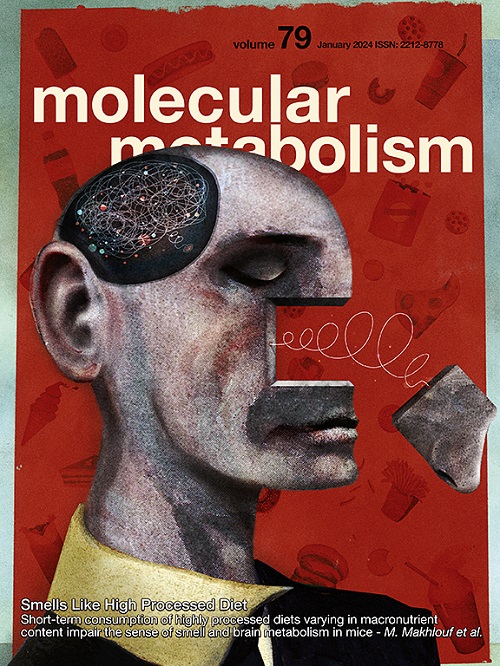膜相关环- ch型指2通过靶向脂肪酸合酶预防代谢功能障碍相关的脂肪肝疾病。
IF 7
2区 医学
Q1 ENDOCRINOLOGY & METABOLISM
引用次数: 0
摘要
目的:代谢功能障碍相关脂肪性肝病(MAFLD)已成为一个重要的公共卫生问题,对人类健康构成重大威胁,并造成巨大的经济负担。研究表明,泛素连接酶介导的底物蛋白泛素化是影响MAFLD肝脏脂质稳态和代谢异常的关键因素。然而,参与这一调节过程的特定酶分子仍有待阐明。我们在HepG2细胞中发表了一个转录组过表达的泛素连接酶,膜相关环- ch型指2 (MARCH2),随后对这些转录组数据的再分析揭示了MARCH2与脂质代谢之间的密切关联。方法:采用重组腺相关病毒(rAAV)转导、慢病毒转导、免疫印迹、定量PCR、组织切片染色、泛素化分析、血清生化分析、免疫沉淀和质谱等多种方法,从分子、细胞和机体水平研究MARCH2在MAFLD进展中的作用和机制。结果:过表达MARCH2,而非其催化失活的连接酶变体,抑制HepG2细胞的脂质积累。此外,在油酸/棕榈酸刺激下,MARCH2经历k48相关的自我多泛素化和随后的蛋白酶体降解。此外,在高脂肪饮食喂养的小鼠中,无论性别,敲除MARCH2都会加剧mafld相关表型的进展,包括体重增加、葡萄糖耐量受损、胰岛素敏感性降低、高胆固醇血症、肝脂质积累和脂肪变性。在机制上,在新生脂肪生成途径中,MARCH2促进脂肪酸合成酶(FASN)的多泛素化和降解。rAAV在肝脏特异性过表达MARCH2可有效降低FASN水平,进一步改善ob/ob小鼠的MAFLD。结论:MARCH2可自我泛素化,在维持MAFLD肝脏脂质稳态中发挥重要作用,药物干预MARCH2- fasn轴是治疗MAFLD全身代谢异常的一种有希望的方法。本文章由计算机程序翻译,如有差异,请以英文原文为准。
Membrane-associated ring–CH–type finger 2 protects against metabolic dysfunction-associated fatty liver disease by targeting fatty acid synthase
Objective
Metabolic dysfunction-associated fatty liver disease (MAFLD) has emerged as an important public health concern that poses a significant threat to human health and imposes a substantial economic burden. Research has demonstrated that ubiquitin ligase-mediated substrate protein ubiquitination is a pivotal factor influencing liver lipid homeostasis and metabolic abnormalities in MAFLD. Nevertheless, the specific enzyme molecules implicated in this regulatory process remain to be elucidated. We have published a transcriptome-overexpressing ubiquitin ligase, membrane-associated ring–CH–type finger 2 (MARCH2), in HepG2 cells, and subsequent reanalysis of these transcriptome data revealed a close association between MARCH2 and lipid metabolism.
Methods
By employing a range of methodologies, including recombinant adeno-associated virus (rAAV) transduction, lentiviral transduction, immunoblotting, quantitative PCR, tissue section staining, ubiquitination assays, serum biochemical analysis, immunoprecipitation, and mass spectrometry, this study investigated the functions and mechanisms of MARCH2 in the progression of MAFLD at the molecular, cellular, and organismal levels.
Results
Overexpression of MARCH2, but not its catalytically inactive ligase variant, inhibited lipid accumulation in HepG2 cells. Additionally, MARCH2 undergoes K48-linked self-polyubiquitination and subsequent proteasomal degradation in response to oleic acid/palmitic acid stimulation. Furthermore, knockout of MARCH2 exacerbates the progression of MAFLD-related phenotypes, including increased body weight, impaired glucose tolerance, reduced insulin sensitivity, hypercholesterolemia, hepatic lipid accumulation, and steatosis, in high-fat diet-fed mice, irrespective of sex. Mechanistically, MARCH2 facilitates the polyubiquitination and degradation of fatty acid synthase (FASN) in the de novo lipogenesis pathway. And liver-specific overexpression of MARCH2 by rAAV effectively reduces FASN levels and further ameliorates MAFLD in ob/ob mice.
Conclusions
MARCH2 undergoes self-ubiquitination and plays an important role in maintaining the liver lipid homeostasis of MAFLD, and drug intervention in the MARCH2-FASN axis is a promising approach for treating systemic metabolic abnormalities in MAFLD.
求助全文
通过发布文献求助,成功后即可免费获取论文全文。
去求助
来源期刊

Molecular Metabolism
ENDOCRINOLOGY & METABOLISM-
CiteScore
14.50
自引率
2.50%
发文量
219
审稿时长
43 days
期刊介绍:
Molecular Metabolism is a leading journal dedicated to sharing groundbreaking discoveries in the field of energy homeostasis and the underlying factors of metabolic disorders. These disorders include obesity, diabetes, cardiovascular disease, and cancer. Our journal focuses on publishing research driven by hypotheses and conducted to the highest standards, aiming to provide a mechanistic understanding of energy homeostasis-related behavior, physiology, and dysfunction.
We promote interdisciplinary science, covering a broad range of approaches from molecules to humans throughout the lifespan. Our goal is to contribute to transformative research in metabolism, which has the potential to revolutionize the field. By enabling progress in the prognosis, prevention, and ultimately the cure of metabolic disorders and their long-term complications, our journal seeks to better the future of health and well-being.
 求助内容:
求助内容: 应助结果提醒方式:
应助结果提醒方式:


